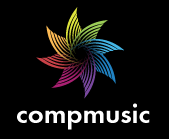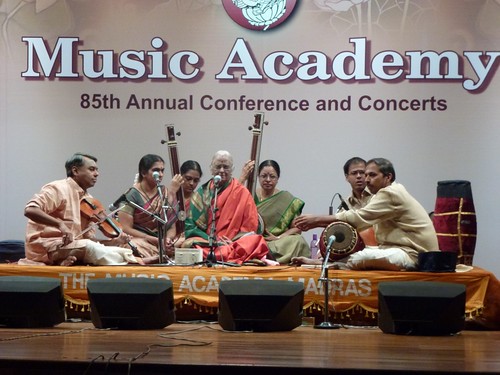Chennai Music Season
I was told that the Chennai Music Season was the major venue for Carnatic music and that to understand the context of this musical culture it was important to be there. So, I had no choice but to spend the second half of December in Chennai, time of the year when most of the events of the Season take place. I was hosted by Prof. Hema Murthy, who heads the CompMusic Carnatic team at IIT-Madras, and with whom I attended some of the Season events. Gopal, a PhD student in Barcelona working in CompMusic, accompanied me. Little I knew about what an amazing music festival this was going to be; I had to experience it to realize its magnitude. In this post I will write a little about it and share my personal experience as an outsider that wants to understand the rich and fascinating Carnatic music culture.
The Music Season of Chennai started in December 1927 as an event to commemorate the founding of the Madras Music Academy. It continued yearly and more local Sabahs (organizations that put together concerts and promote Carnatic music) joined in and organized their own festivals during the same period. The Season has no central organization, it is a completely distributed event that has flourished through the effort of many people and the sponsorship of many private institutions. It is impossible to know (at least no one was able to tell me) how many Sabahs organize events during the Season and how many concerts are actually happening. According to some articles I read in The Hindu (the reference newspaper in Chennai) more than 1500 concerts take place each year during the months of December and January and it is the biggest music festival in the world. I believe it!!.
The Music Academy not only has maintained the leadership in the Season but also a prominent influence in the world of Carnatic music. Apart from holding the annual December events, the Academy is a music school, it has a very large library and a digital music archive, it publishes a journal and it promotes Carnatic music through quite a number of initiatives. The December events are organized in the form of an Academic Conference and a Concert Festival, and this year was its 85th edition. The Conference includes a series of lecture demonstrations that take place every morning, from 8am to 10am (yes, starting at 8am!!!), and the Festival has concerts that start at 9:15am and go until 9:30pm every day non-stop. The festivals of the other Sabahs include mainly concerts that also run for the whole day. There are quite a number of formalities surrounding each festival and each particular concert; recognition awards are given every year and in the different events there are regular mentions of gratitude for the musicians, distinguished people and sponsors.
A Carnatic music concert, kutcheri, is a very well defined musical unit, with a structure attributed to Ariyakudi Ramanuja Iyengar (some scholars at this year's conference disagreed with this attribution) and widely used since the 1960s. The duration of the concerts I attended were either 2 or 2.5 hours long (time was quite exact) and the pieces performed followed the pre-stablished order. The concerts have quite a good balance between pre-composed pieces and improvisatory forms (N. Ramanathan would disagree with the use of the term improvisation in Carnatic music, Ramanathan, 2007). In most concerts there is no written program and the performers do not announce the pieces either. Part of the interest, challenge?, is to identify the kritis, ragas and talas throughout the concert. It is amazing the number of expert listeners, rasikas, that can do that and that actively participate in the concert by tapping out the talas and reacting to the performers creativity by clapping or through verbal exclamations. The clapping at the end of the concerts is quite moderate, compared with what I am used to, even in the case of standing ovations, which I saw in two concerts.
The morning academic sessions that I attended at the Music Academy, lecdems, were quite practical. Most of them were given by practicing musicians and they included both a theoretical presentation together with some demonstration or performance. Attending them I realized that most Carnatic music performers are somewhat involved in musicological studies and that all musicologist are music practitioners (that is not the case in western classical music). All the lectures where amazingly well attended (at 8am!!!) and the audience included experts (recognized as such and seated in the first two rows), musicians, rasikas and general public. There was quite a number of formalities around the lectures but at the same time there were many engaging discussions that showed a very alive community and that despite the long tradition many issues are being challenged and the music is evolving. Too bad (for me) that many talks were in Tamil, and even in the "English" talks the speaker would easily change to Tamil quite often. I attended talks covering a wide variety of issues, including gamakas, talas, ragas, computer transcription, kutcheri structure, and notational systems. All talks were very interesting for me.
I attended concerts mainly at the Music Academy. Most of the relevant musicians active in Carnatic music performed in at least one of the 81 concerts that were organized there. The most important musicians had evening slots (4:15pm or 7:00pm) and the incoming artists had the morning and afternoon ones. I had the opportunity to listen some of the older and most respected artists like R. Vedavalli or K. Sivaraman, some of the consolidated and currently most acclaimed artists like T. M. Krishna (a collaborator of CompMusic) or Sanjay Subramanian, and some very young upcoming artists like Abhishek Raghuram. Of course I could not appreciate most of what these musicians were doing, but I experienced wonderful musical moments with a communication and expressive power that only a few times I experienced in concerts. Having learned a tiny bit about this music culture and being part of a concert in the most adequate context, makes the event a complete musical experience. The space, the formalisms, the audience, the indian smells, .. they all help in making the listening act a highly fulfilling and enriching moment, difficult to describe in words but that I will never forget.
Many people say that Carnatic music is an art struggling to survive. After being at the Chennai Music Season I have a completely different impression. A lot of people attended the concerts, many of the evening concerts at the Music Academy were completely full, and all were well attended. The Hindu had at least two full pages every day dedicated to the Music Season, with all kinds or articles related to Carnatic music. Most of the concert reviews showed amazing musical expertise (at least for me) with details and comments that I have rarely seen in music reviews in Europe. Shortly after many concerts (within two hours) a discussion started in rasikas.org (a forum of Carnatic music enthusiasts). For example after the T. M. Krishna concert I attended, in the rasikas forum took place this discussion (I guess this was a special controversial concert). Maybe all this does not reflect the normal context of Carnatic music, but even considering it a very special situation I do not know of any other musical event with such social presence and engaged followers.
To finish this post I want to write about the Tag Digital Listening Archives of the Music Academy. These archives were inaugurated in 2008 to preserve the recordings that the Academy makes of all its concerts plus other recordings that have been donated to the Academy. It can become a huge archive. They already have a few thousand hours of recordings available digitally and accessible in a specially designed space with quite a number of computers through which any rasika can access and listen to them. Together with Hema Murthy we had a visit to the archives and a meeting with the president of the Academy, Sri N. Murali, and the main donor and person in charge of the archives, Sri R. T. Chari. We just wanted to learn about the archives and let them know about CompMusic and our desire to have, in not too distant future, technology that would facilitate the use of the their archives and offer many new browsing functionalities. For me this archive is a very clear example of an existing context for which the technologies we are developing in CompMusic could be of use.
What a learning experience this stay in Chennai was!!!
…xavier



